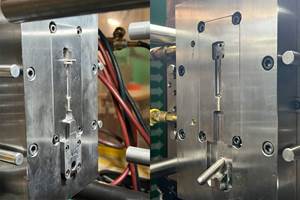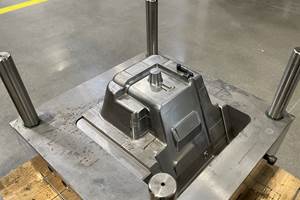A Look Back at 3D Printing in 2015
3D printing is an exciting industry – there’s always something new going on.

3D printing is an exciting industry – there’s always something new going on. In looking back at 2015, there was plenty of interesting new developments that are being implemented or are on the horizon. Here’s a look:
- During the 3D Printing USA Conference in Santa Clara, Calif., hosted by UK-based IDTechEx, it was proclaimed that thanks in part to 3D printing, this is the “golden age for material scientists.” This statement from John Hornick, partner of Finnegan, Henderson, Farabow, Garrett & Dunner, and intellectual property law firm that has a focus on 3D printing and additive manufacturing (AM). He was not alone in those thoughts. Throughout the two-day 3D printing conference, much conversation centered around materials.
- Also during the 3D Printing USA Conference, Rachel Gordon, technology analyst with IDTechEx (the conference’s host) gave an update on the state of the 3D printing industry as it’s been quite an interesting 2015. “With the stock price drop of 3D Systems and Stratasys there is currently a very negative feel. But is it all bad news?” she asked. “I firmly believe no. I believe there was too much hype for the possibilities of 3D printing— for instance everyone at home could make anything they want—that is not reality.” But Gordon said there are signs the 3D printing industry is going in a good direction. For instance, larger multinational companies are getting involved in the industry, which will bring a lot of manufacturing expertise that will help the system grow.
- Plastics Technology’s Matt Naitove reported that additive manufacturing (AM), better known as 3D printing, is big news these days, and the news in AM is “Big,” as in Big-Area Additive Manufacturing, or BAAM. Visitors to June’s Amerimold exposition in Rosemont, Ill., got an impression of where BAAM is headed. Oak Ridge National Laboratories, Oak Ridge, Tenn., showed off examples of its BAAM work at its Manufacturing Demonstration Facility. ORNL made news this past January with its 3D printed Shelby Cobra sports car, which debuted at the North American Auto Show.
- Is 3D printing a viable alternative to injection molding? Well, the University of Sheffield (South Yorkshire, England) believes the answer is yes—and they hope to be the ones to achieve it. The university plans to build a machine that will produce parts up to three times larger and 100 times faster than current comparable additive manufacturing (AM) machines. The university says this makes it capable of challenging conventional injection molding for high volume production.
- Also from Matt Naitove: additive manufacturing appeared in various guises throughout October’s Fakuma 2015 show in Friedrichshafen, Germany. Arburg (U.S. office in Rocky Hill, Conn.) brought three of its Freeformer machines, the first to use standard molding pellets, to Fakuma. Two of them formed part of “Industry 4.0” exhibits of “personalized manufacturing” in which the Freeformers applied individualized decoration to injection molded parts. One new wrinkle was an automated cell in which a Freeformer was tended by a Kuka robot instead of a human operator. Arburg officials noted in a Q&A session with the press that its 3-axis Freeformer model is meeting current demands of the market and there is little push from customers so far to commercialize a more expensive 5-axis version. More immediate development priorities, the officials said, were nitrided components to resist wear, a larger build envelope, and printing of high-temperature resins.
- Covestro and Polymaker, a Shanghai, China-based producer of high-quality filament for extrusion-based desktop 3D printers, have developed Polymaker PC, a new line of polycarbonate-based materials specifically designed for extrusion-based desktop 3D printers The first two members of this new material family are Polymaker PC-Plus and PC-Max, which have been formulated and engineered to bring PC to the extrusion-based desktop 3D printers. They have reportedly achieved this by lowering the printing temperatures from 300 - 320 ºC down to a moderate 250 - 270 ºC, and significantly improving the warping resistance. Polymaker PC-Max further offers advanced mechanical properties—toughness, in particular—making it suitable for mechanically demanding applications.
- Perhaps showing its growth in the automotive market, this was the first year for the Society of Plastics Engineers (SPE) Automotive Composites Conference and Exhibition (ACCE) show to feature a track specifically dedicated to additive manufacturing/3D printing. Ellen Lee, materials and manufacturing research for Ford, Dearborn, Mich., said that while additive manufacturing isn’t new for the automaker (almost 30 years of experience), the company is focused on going beyond the prototype level to the direct production of end use, functional parts. Recently, the company developed a dedicated new additive manufacturing research program to explore the potential of new technologies to manufacture vehicle-ready parts.
- Mitch Free, co-founder and CEO of the newly launched CloudDDM (Atlanta, GA, US), believes a new approach to additive manufacturing is required in order for the technology to reach its full potential. “I realized there were two needs for high-quality, end-use parts in the market that were not being addressed by additive manufacturing service providers,” he told Plastics Technology. “The first is speed. Whether a customer needs a prototype or a 3D-printed jig or fixture— the faster they can receive it, they faster they can move their project along. As the old adage goes, ‘time is money’ for our customers and we are sensitive to that.” The facility features 100 3D printers running 24 hours, 7 days a week. Free said that the company is using purpose-built additive manufacturing machines that are not commercially available. The company can produce parts using several materials including ABS, polycarbonate, polycarbonate-ABS and Ultem 1010.
Related Content
3D Printing of Injection Molds Flows in a New Direction
Hybrids of additive manufacturing and CNC machining can shorten tooling turnaround times.
Read MoreDaimler, OMIC Evaluate Wire-Fed DED for Moldmaking
3D printing a core and cavity on machine from Gefertec, followed by machining, allowed for a complete mold tool to be produced in three days.
Read MoreCustom Molder Manages Growth on Several Fronts
Adding people, plants and machines, expanding capabilities in LSR, high-tonnage presses, automation and 3D printing—EVCO Plastics maintains momentum through challenging times.
Read More420 Stainless Steel Now Qualified With TrueShape 3D Printing Technology
NPE2024: Mantle's Additive Manufacturing Technology is Designed for Precision Tooling
Read MoreRead Next
How Polymer Melts in Single-Screw Extruders
Understanding how polymer melts in a single-screw extruder could help you optimize your screw design to eliminate defect-causing solid polymer fragments.
Read MoreWhy (and What) You Need to Dry
Other than polyolefins, almost every other polymer exhibits some level of polarity and therefore can absorb a certain amount of moisture from the atmosphere. Here’s a look at some of these materials, and what needs to be done to dry them.
Read More
























